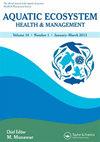对称与孤独:两国关注领域的现状与教训
IF 0.8
4区 环境科学与生态学
Q4 ENVIRONMENTAL SCIENCES
引用次数: 5
摘要
关注区域是指五大湖水域内地理位置不同的区域,这些区域的污染程度最初是由国际联合委员会水质委员会确定的,后来在1987年的《五大湖水质协定》中被列为需要采取补救行动的区域。43个受关注地区中有5个是两国的(加拿大、美国),并且位于流经大湖的每条河流或连接渠道上。正如《协定》所呼吁的那样,实施生态系统方法对两国关注领域提出了独特的挑战,因为有多个司法管辖区和社区,因此更大的制度、计划和参与复杂性。我们对每个两国关注领域进展的回顾表明,两国和以生态系统为导向的方法正在圣玛丽、圣克莱尔和底特律河关注领域进行,而尼亚加拉河和圣劳伦斯河关注领域则在更独立的国内轨道上进行。我们对底特律河和圣劳伦斯河关注区域的案例研究分析表明,完善和正式的治理框架,建立非正式网络,并在以科学为中心的方法中保持灵活性,创造了更适合两国、以生态系统为导向的补救手段的条件。本文章由计算机程序翻译,如有差异,请以英文原文为准。
Symmetry and solitude: Status and lessons learned from binational Areas of Concern
Areas of Concern are geographically distinct areas within the waters of the Great Lakes that are contaminated to the extent that they were originally identified by the International Joint Commission’s Water Quality Board and later codified in the 1987 Great Lakes Water Quality Agreement as areas requiring remedial actions. Five of the 43 Areas of Concern are binational (Canada, USA), and are located on every river or connecting channel that drains a Great Lake. Implementing an ecosystem approach, as called for in the Agreement, presents unique challenges for binational Areas of Concern due to multiple jurisdictions and communities, and hence greater institutional, program and participatory complexity. Our review of progress in each of the binational Areas of Concern suggests that a binational and ecosystem-oriented approach is underway in the St. Marys, St. Clair and Detroit River Areas of Concern, while the Niagara River and St. Lawrence River Areas of Concern are proceeding on decidedly more independent domestic tracks. Our case study analysis of the Detroit River and St. Lawrence River Areas of Concern suggest that well developed and formal governance frameworks, the establishment of informal networks, and maintaining flexibility within a science-focused approach create conditions better suited to a binational, ecosystem-oriented means of remediation.
求助全文
通过发布文献求助,成功后即可免费获取论文全文。
去求助
来源期刊

Aquatic Ecosystem Health & Management
环境科学-海洋与淡水生物学
CiteScore
1.70
自引率
0.00%
发文量
1
审稿时长
18-36 weeks
期刊介绍:
The journal publishes articles on the following themes and topics:
• Original articles focusing on ecosystem-based sciences, ecosystem health and management of marine and aquatic ecosystems
• Reviews, invited perspectives and keynote contributions from conferences
• Special issues on important emerging topics, themes, and ecosystems (climate change, invasive species, HABs, risk assessment, models)
 求助内容:
求助内容: 应助结果提醒方式:
应助结果提醒方式:


